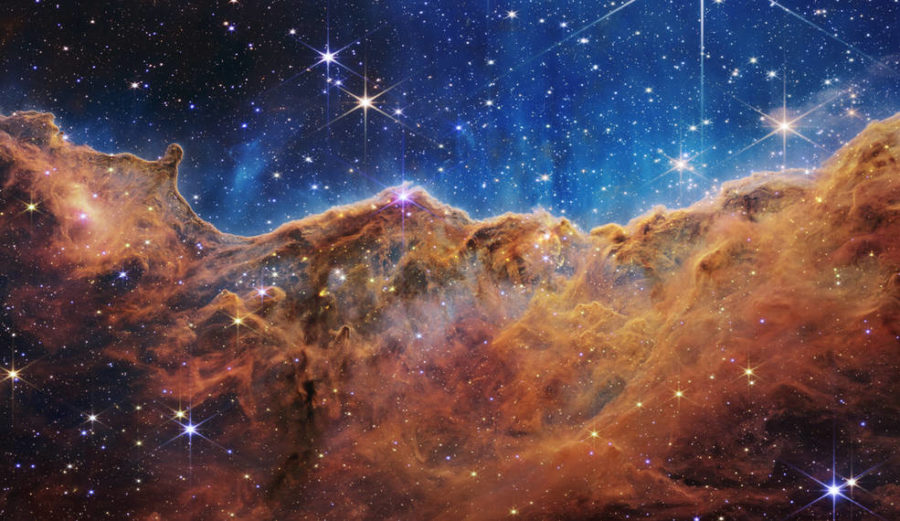The science behind the clearest images of space ever recorded
November 18, 2022
Telescopes are one of the only things that help humans see what is out past our atmosphere.
Modern telescopes focus images using a curved mirror that reflects light. The larger the mirror, the more light it can reflect, and the better you can see. The only problem with most telescopes is that they see the light from on planet Earth. This means that the light the telescope reflects is light from thousands and hundreds of thousands of years ago, so we can’t see what is truly going on in our universe. Another issue that arises is our ability to only see light in the visible range. Telescopes can be engineered to transform other kinds of electromagnetic radiation that we normally cannot detect into visible light that we can see. This is where the James Webb Space Telescope (JWST or Webb) especially shines.
The Webb telescope is, according to NASA, an “…infrared telescope with an approximately 6.5 meter primary mirror.” Six and a half meters is over 21 feet, which is more than the combined height of three average people. Due to this large mirror, the Webb telescope is able to create extremely clear and detailed images. The telescope plans to have a mission duration of at least ten years, as well as travel one million miles away from earth.
The JWST’s goal is not only to capture images of nearby planets and formations, but also capture images of light from billions of years ago, traveling from some of the universe’s very first galaxies. NASA produced an article on their Webb Telescope online page answering the question: “How does Webb See Back in Time?” The science behind this is that light takes time to travel through space to reach our cameras. NASA gives an example of this science relating to the moon: “The Moon is Earth’s closest companion, at about 239,000 miles (390,000 km) away. Light takes around 1.3 seconds to travel the distance to Earth. When we look up at the sky, we see the Moon as it was 1.3 seconds earlier.” Following this logic, because of the massive size of the universe and the amazing distance between objects in it, we and our cameras see things as they were billions of years ago. Because of this, we can observe how galaxies looked right after the birth of the universe.
Along with capturing detailed images, the telescope also allows us to see what we cannot with our bare eyes. NASA states that the infrared telescope has been created to “… detect light outside the visible range to show us otherwise hidden regions of space.” These areas are hidden because the shorter waves of visible light often bounce off of surrounding dust particles, so they do not reach the camera. This creates a problem when observing things like nebulae because they are made of dust and gas particles, which prevents us from seeing what lies inside of them. Infrared waves are longer than visible light waves, and therefore are able to maneuver their way through the particles and to our detection, so that we can see what lies behind these large dust clouds.
The image recorded here by JWST in infrared light is an image of a part of the Carina Nebula, located 7,500 to 8,500 light years away from Earth. Nebulae are enormous clouds of gas and dust often formed by the birth or death of a star. This part of the Carina Nebula is a star-forming region, and this image gives scientists a detailed view into the birth of stars.
Another amazing image taken by the Webb telescope is the image of galaxy cluster SMACS 0723. This image showcases gravitational lensing, which occurs when a massive object’s force of gravity is so great that it bends the light of objects surrounding it. Featured here are hundreds of galaxies, and even the faintest dots in this image are galaxies as well.
The images produced by this telescope are the clearest that we have ever seen, but that is not JWST’s only impressive quality. One unique and incredible scientific feat achieved on the telescope is its ginormous sun shield, which is about the size of an average tennis court (69.5 feet by 46.5 feet). The sunshield serves to protect it from light and heat radiating from other celestial bodies. The sunshield is made of five extremely thin layers that do not touch to prevent them from transferring the heat that they absorb.
Other fun facts about JWST:
- It weighs 13,650 pounds when on Earth.
- The operating temperature is -390 degrees Fahrenheit.
- It launched on December 25 of last year, 2021.
- The first images released from Webb were shown on July 12, 2022.


















